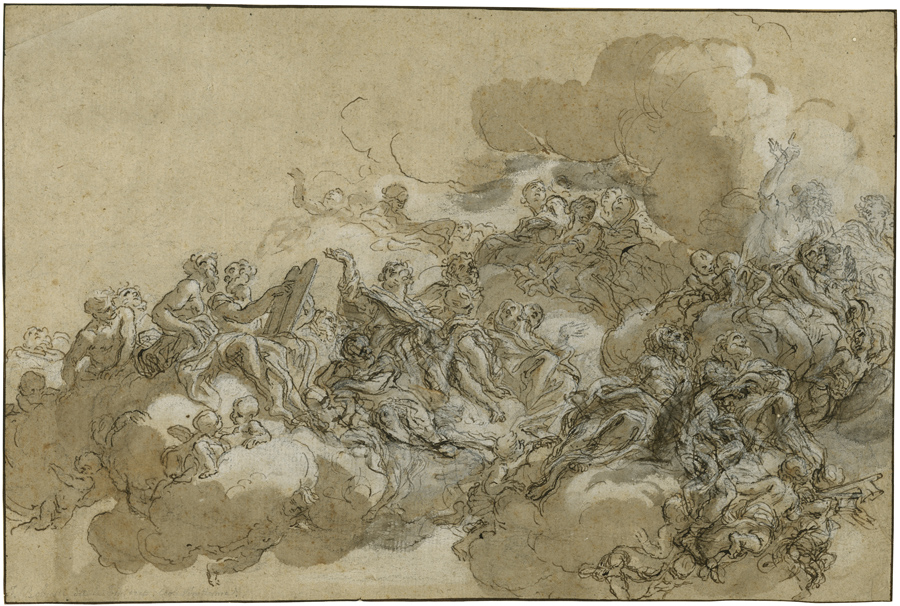Loading the page ...
Giovanni Battista Gaulli
(known as Il Baciccio, 1639 Genoa – 1709 Rome)
Detail Study for "The Assumption of St. Agnes". Pen and brown ink, brown wash, white heightening, over a light preliminary drawing in black chalk. 25.5 x 39 cm.
A supreme lightness and a seemingly effortless drawing style are the distinguishing features of Gaulli’s detail study for a fresco in the dome of the church of S. Agnese on the Piazza Navona in Rome. Several oil sketches and a series of detailed studies that he drew for this project have survived (see Giovan Battista Gaulli. Il Baciccio, edited by M. Fagiolo dell’Arco, D. Graf, F. Petrucci, Milan 1999, pp. 130–133). This sheet is a primo pensiero in the truest sense of the word, having been conceived at the very beginning of Gaulli’s project for the decoration of the dome, which never materialized. The artist has sketched the scene rapidly and with great concentration; the many figures notwithstanding, he has produced a balanced overall composition, while at the same time accurately defining the distribution of the chiaroscuro with flowing washes and white heightenings.
Crucial to a better understanding of the overall decorative scheme is the detailed modello in Düsseldorf, which probably dates to around 1690). The centre of the dome fresco is occupied by the figure of St. Agnes who, accompanied by Mary, is kneeling humbly before Christ with the Cross and God the Father. The Metropolitan Museum of Art in New York possesses a large-format preparatory drawing for a part of the composition; this is a study for the saints and the music-making angels positioned on the clouds above them to the left of the Assunzione. The present sheet is very closely related to this drawing in stylistic and compositional terms and, given its sketch-like execution, more than likely preceded it.
Gaulli’s endeavours ultimately came to no avail. In 1670, principe Giovanni Battista Pamphili commissioned Ciro Ferri to paint the dome of S. Agnese, a project he had failed to complete by the time he died in 1689. Gaulli, who had already executed allegorical Virtues in the four principal pendentives in the same church between 1666 and 1672, evidently planned a new project based on his own design, but his attempts to secure the contract proved unsuccessful. Instead, the frescoes were finished in an artistically unconvincing manner by Ferri’s pupil Sebastiano Corbellini.
Finally, there is the interesting question of the date of the present drawing, which may have been executed as early as the mid-1670s. In stylistic terms it reveals close parallels with two studies of prophets and evangelists in Düsseldorf done by Gaulli around 1675 in connection with the frescoes for the Il Gesù Church. This would mean that the artist had given serious thought to the project for the dome fresco – possibly in the light of the slow progress made with the painting – long before the death of his rival Ferri. Regrettably, Gaulli’s ingenious scheme never came to fruition. The Baroque brilliance and the ingenious inventiveness of his design are on a par with his masterpiece in the Gesù, the fresco on the Triumph of the Name of Jesus.
